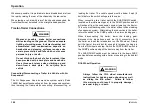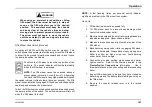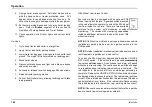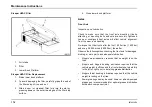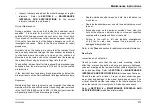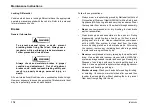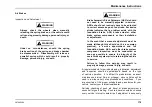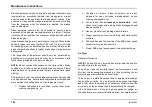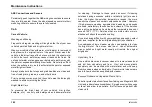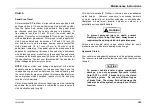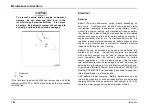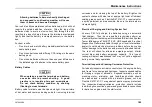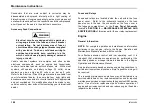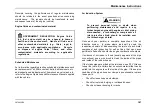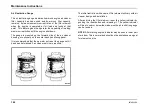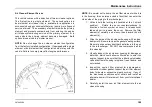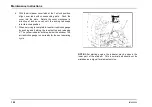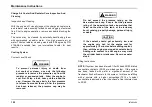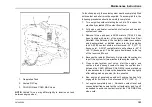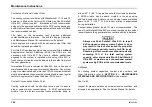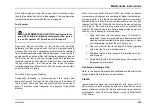
Maintenance Instructions
Brake chamber push rods on original equipment chambers now
incorporate an overstroke indicator (an orange paint marker
near the base of the push rod) to aid adjustment checks. If the
push rod is clean and the orange marker can be seen protruding
from the chamber when the brakes are applied, the brakes
require adjustment.
Slack adjusters should also be checked to ensure proper
operation of the adjuster mechanism at every interval. Push rod
travel should be less than the maximum allowed stroke without
brakes dragging.
Inspect brake linings every maintenance interval. When brake
shoes (or pads) are worn to within 1/16 inch (1.6 mm) of rivets
(or backing plates), as indicated by a line or other feature on the
edge of most brake shoes (or pads), brake shoes (or pads) must
be replaced.
This inspection or adjustment should only be performed by
qualified service personnel and must be in accordance with
instructions provided by the Service Manual.
NOTE: Do not overlook the brakes on the trailer either. Brake
condition on a trailer is just as important as the tractor. Proper
brake balance on trucks and tractor trailers is essential for good
braking.
At least once a year, the entire brake system must be inspected
by a trained mechanic. Deteriorated components or components
worn outside of specifications must be replaced. Check:
1.
Rubber components for condition, cracks, tears, wear,
missing components, etc.
2.
Condition of drums,
brake chambers,
and slack
adjusters for wear, corrosion, maladjustment, cracks,
missing components, etc.
3.
For air leaks. No air leakage is permissible. Also,
check for air leaks with parking brake disengaged and
wheels chocked.
4.
Hose or pipes for rust, damage, deterioration.
5.
Proper operation of service, parking, and trailer brake
controls.
6.
The condition and full insertion of the ABS wheel speed
sensors, wiring, and connectors.
7.
Proper ABS wheel speed sensor-to-exciter teeth gap.
Air Dryer
General Information
NOTE: The use of an air dryer does not eliminate the need to
periodically drain the air tanks.
The air dryer removes humidity (water), air compressor oil, and
dirt from the incoming compressed air, thus protecting the air
system against deterioration and restriction.
The air dryer is installed between the air compressor discharge
line and the air tanks. The air dryer has a desiccant cartridge
and a filter which is serviced as an assembly. Moisture from the
air collects on the desiccant and is automatically discharged.
Life and performance of the air dryer depends on usage, air
humidity levels, environmental temperatures, air compressor oil
180
3878859R2
Summary of Contents for ProStar+ Eagle Series.
Page 4: ...Operator s Manual ProStar Series Printed in the United States of America 3878859R2 ...
Page 12: ...Table of Contents Section 10 Index Index 235 viii 3878859R2 ...
Page 26: ...Model Description Exterior Components 14 3878859R2 ...
Page 28: ...Model Description 16 3878859R2 ...
Page 59: ...Controls Features 3878859R2 47 ...
Page 70: ...Controls Features Declination Zone Map 58 3878859R2 ...
Page 93: ...Controls Features Center Dash Panel Wing Panel 3878859R2 81 ...
Page 128: ...Sleeper Features 116 3878859R2 ...
Page 182: ...Operation 170 3878859R2 ...
Page 241: ...Maintenance Intervals and Specifications Typical Interior Fuse Panel Layout 3878859R2 229 ...
Page 262: ...Index 250 3878859R2 ...

